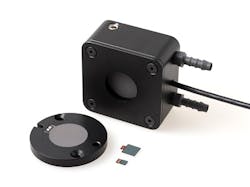Laser power monitoring improves process stability
Figure 1: Stability of a HeNe gas laser during warmup. The signal fluctuations are caused by the warming up of the gas inside the tube and the tube itself. Image courtesy of Repair FAQ.
Laser systems are used in industrial processing for applications such as cutting, welding, or marking. The careful adjustment of the power of a laser system needs to be ensured to achieve high-quality results and reproducibility. A part might not be cut with too low power, whereas the raw edge might be rough at too high powers. Monitoring the laser power is therefore crucial for an effective process control.
Most laser systems exhibit variations of the light intensity over time. There are short-term fluctuations due to the laser source stability and/or a thermal drift (see Fig. 1). These modulations are of the time scale of minutes or hours. Additionally, the laser power drops in the course of the laser lifetime by up to 20%. The deterioration of optics aligned along the beam path cause a decrease in output power as well in the long term. Both types of fluctuations might cause a lowered throughput due to defective products or additional maintenance times.
Continuous or intermittent power measurement
The implementation of a laser power monitor along the optical path inside the system can either be at the source (e.g., behind the back mirror) or close to the beam output (e.g., inside the processing head). It allows for the continuous detection of power instabilities and helps to adjust the pump power immediately. Continuous monitoring of power is beneficial for both the user as well as the manufacturer because the operation scheme can be logged without gap and malfunction is easier to track down.
Alternatively, the measurement can be carried out intermittently. This is often realized with a measurement unit located next to the machining area. For example, after each 10 machining cycles, the processing head moves to the power detector module and a measurement is taken.
Both methods have similar requirements on the power monitors as they demand accurate, fast, and compact detectors. Thermopile laser power detectors such as the gRAY line produced by greenTEG are designed for OEM integration into laser systems at all wavelengths from UV to MIR. Various detectors are available with their specifications adjusted to the requirements of different measurement scenarios. In the following sections, the benefits for different measurement tasks will be presented and compared to conventional detectors.
Fast detectors for real time control and high throughput
An effective feedback loop allows for instant control of the critical parameter. The measurement of the signal is a crucial component of the overall time necessary to carry out a control cycle. Thermopile disc detectors are most commonly used to measure laser power above 100 mW. Physics, however, puts a limit to the measurement speed of such detectors. Because of their working principle, the thermal capacitance of the detector determines the rise time, resulting in typical values of 1-5 s. greenTEG has developed a thermopile detector for medium powers up to 50 W. As its key feature, the detector exhibits a rise time of just 200 ms. Such low rise times are achieved by an axial pile arrangement combined with a minimized thermal mass. Both characteristics--a short heat path and low thermal capacitance--lead to fast thermal equilibration (see Fig. 2).
The robust housing provides both mechanical and thermal stabilization. Further, amplification electronics are integrated in the housed detectors. The analog voltage signal is internally amplified and normalized to facilitate read-out. In applications where power is measured intermittently, such a fast sensor lowers the measurement time significantly and hence increases production throughput. In continuous measurement scenarios, countermeasures for a fluctuating laser power can be taken immediately.
High accuracy at lowest power
The two key specifications for a power detector are its power range and its wavelength range. Within this parameter space, greenTEG has identified a region where no convenient detectors currently exist. This gap is located at long wavelengths (beyond the sensitive spectrum of photodiodes) and low powers (below the resolution limit of conventional thermopile discs). This gap is now covered with the gRAY sensor components and PCB-mounted detector. Both are sensitive even at micro Watt levels and detect the smallest power fluctuations.
With their compact size (down to 4x4 mm2) they can be mounted into any system where space is limited. Compared to photodiodes, no angular dependence of the sensitivity is observed and because of the flat absorption spectrum of the broad band absorber coating, the spectral dependence of the sensitivity is very small.
By Dr. Susanne Dröscher
greenTEG, Zurich, Switzerland
Figure 2: Transient signal of greenTEG detector compared to conventional disc detector. It takes 200 ms for the signal to rise from 0 to 95%, whereas 1-2 s are more typical. Image courtesy of greenTEG.
